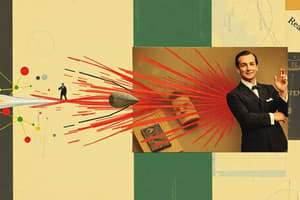Podcast
Questions and Answers
What happens to energy when it is transferred from a hotter object to a cooler object?
What happens to energy when it is transferred from a hotter object to a cooler object?
- It becomes useless energy.
- It is conserved. (correct)
- It is lost forever.
- It is created.
What is an example of energy dissipating in a tumble dryer?
What is an example of energy dissipating in a tumble dryer?
- Generating light.
- Producing sound waves. (correct)
- Creating electrical energy.
- Transferring heat to the clothes.
How is energy typically dissipated into the surroundings?
How is energy typically dissipated into the surroundings?
- By converting to kinetic energy.
- By sound waves and heating. (correct)
- Through electromagnetic waves only.
- By increasing potential energy.
Which of the following statements about energy is true?
Which of the following statements about energy is true?
What is meant by energy being 'dissipated'?
What is meant by energy being 'dissipated'?
Which of the following statements accurately reflects the Law of Conservation of Energy?
Which of the following statements accurately reflects the Law of Conservation of Energy?
How does the height of an object affect its gravitational potential energy?
How does the height of an object affect its gravitational potential energy?
What happens when a ball falls to the ground regarding its energy stores?
What happens when a ball falls to the ground regarding its energy stores?
Which type of energy store is exemplified by batteries and fuels?
Which type of energy store is exemplified by batteries and fuels?
What does a stretched or squashed object possess in terms of energy?
What does a stretched or squashed object possess in terms of energy?
How is energy transferred when a person lifts a book onto a high shelf?
How is energy transferred when a person lifts a book onto a high shelf?
How does temperature affect an object's thermal energy storage?
How does temperature affect an object's thermal energy storage?
When considering energy transfer via radiation, which phenomenon is involved?
When considering energy transfer via radiation, which phenomenon is involved?
Flashcards
Thermal Energy Transfer
Thermal Energy Transfer
The transfer of energy from a hotter object to a cooler object. This occurs when there is a temperature difference between the objects.
System
System
A group of objects that interact with each other.
Dissipated Energy
Dissipated Energy
Energy that is stored in less useful ways, often released as heat to the surroundings. It is considered 'wasted' because it cannot be used to do useful work.
Energy Dissipation
Energy Dissipation
Signup and view all the flashcards
Energy Conservation
Energy Conservation
Signup and view all the flashcards
Law of Conservation of Energy
Law of Conservation of Energy
Signup and view all the flashcards
Kinetic Energy
Kinetic Energy
Signup and view all the flashcards
Gravitational Potential Energy
Gravitational Potential Energy
Signup and view all the flashcards
Thermal Energy
Thermal Energy
Signup and view all the flashcards
Chemical Energy
Chemical Energy
Signup and view all the flashcards
Elastic Energy
Elastic Energy
Signup and view all the flashcards
Energy Transfer
Energy Transfer
Signup and view all the flashcards
Work Done
Work Done
Signup and view all the flashcards
Study Notes
Energy Conservation
- Energy cannot be created or destroyed; it's conserved.
- Energy can be stored and transferred between different energy stores.
- Energy is measured in joules (J). A kilojoule (kJ) is 1000 joules.
Energy Stores
- Kinetic Energy Store: Amount depends on object's speed. Higher speed = more kinetic energy.
- Gravitational Potential Energy Store: Amount depends on the height of the object. Higher height = more gravitational potential energy.
- Thermal Energy Store: Amount depends on the temperature. Higher temperature = more thermal energy.
- Chemical Energy Store: Found in batteries, foods, and fuels. Energy is transferred via chemical reactions.
- Elastic Potential Energy Store: Found in stretched or squashed objects.
Energy Transfer
- Mechanical Working: Energy transferred when a force moves an object.
- Radiation: Energy transferred as waves (light, sound).
- Heating: Energy transfer from a hotter object to a cooler object.
- Energy Transfer within a System: Energy can be dissipated.
Dissipation of Energy
- Energy is lost to the surroundings, usually through heating, but also radiation (e.g., sound).
- Dissipation depends on the system. Example: A tumble dryer transfers electrical work into thermal and kinetic energy for drying clothes, but also dissipates energy through sound and heating.
- Dissipated energy is stored in less useful ways in the surrounding environment.
The Law of Conservation of Energy
- French philosopher Émilie du Châtelet's experiment demonstrated that energy is conserved when objects fall.
- Her findings support the Law of Conservation of Energy.
Studying That Suits You
Use AI to generate personalized quizzes and flashcards to suit your learning preferences.





